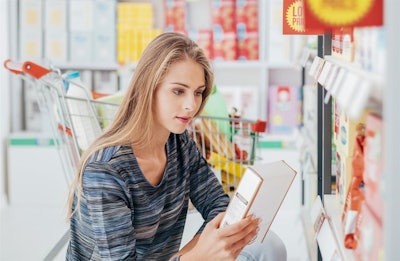
Consumers are not only concerned with what a food product contains, but are also concerned with its packaging. That’s why it is important to keep track of the latest packaging trends in the market. Lynn Dornblaser, director of innovation and insight at market intelligence group Mintel, presented at the 2018 International Production & Processing Expo (IPPE), the latest food packaging trends.
Those trends are:
1. Keep the label clean and simple
“Clean labels are seen as healthy,” explained Dornblaser. That’s why it’s better if a product has a label with a simple and easy-to-read font, an understandable list of ingredients and not too many elements to avoid consumers’ confusion. Finding a balance is not simple, because a minimalist label can make consumers believe is another “retailers really cheap” product.
A Mintel poll demonstrated that for U.S. costumers, “healthy foods don’t include artificial ingredients.” While the use of artificial ingredients and colors is declining, the claim to reduce them keeps increasing, added Dornblaser.
2. Tell the truth
“‘No artificial’ claims aren’t always enough to prove naturalness,” explained Mintel’s specialist. If the label says something but the product doesn’t go in accordance with it, consumers are going to question it, they’re not going to believe it, and they’re going to express that skepticism in their comments on social media and company webpages.
That’s when it comes the “zero moment of truth” or “ZMoT”, “the vast majority of consumers research products online before purchasing.” According to a Mintel investigation, 92 percent of consumers compare prices online across multiple retailers; 91 percent read customer reviews online; and 89 percent compare online prices to in-store prices.
3. Eco-responsible packaging
“Packaging that better delivers, protects, and preserves food, and also reduces or eliminates food waste can become a lifeline between brands eager to reach consumers with pointed messaging about food waste and consumers who are demanding big brands to do more to protect and preserve the planet’s resources,” said Dornblaser.
Now, consumers are aware of food waste and look for packaging solutions to tthat address hat issue. A Mintel poll revealed that 50 percent of people believe “the right package can help reduce food waste,” while a 46 percent think that packaging material can affect the quality of food. Another 41 percent said that packaging with features — like resealability or portion control — provide added value; and 39 percent said brands should work to make packaging more eco-responsible.
4. E-commerce packaging considerations
U.S. e-commerce sales for 2017 are estimated at almost $422 billion, said the Mintel director of innovation and insight. There’s also a projection of a 72 percent increase in such sales over the next five years. This is why it is important to focus on e-commerce and what kind of packaging can provide the quality you want in your product and an experience for the costumer.
One in four people said better designed packaging of brand products would help their purchase decision, found Mintel’s research that asked people what would influence their purchase decision when using online retailer Amazon Go.
To improve e-commerce packaging, Dornblaser recommends: to put branding inside and outside the package, to include return information, to use an appropriate size to fit the product, reduce excess internal packaging and provide an easy way to open it.
5. Transparency and functionality
“Transparent packaging builds trust,” said Dornblaser. Mintel research confirms that it’s important to be able to see the food inside the packaging, which can be achieved using windows. With that window, consumers can inspect the product and see its freshness and quality.
It’s also important to have a functional package, because than can change the way the product is consumed. For example, there are bags that become bowls, so it’s easier for the customer to consume the product.
6. Use the nicest pictures you have
Mintel’s research about the 10 products with highest appealing packaging score found that the products with the nicest photos were preferred by the consumers. In a deeper analysis, the 10 products with the highest appealing packaging and highest purchase intent were products with nice pictures and a window on the package so the customer can see the content. Convenience was the third thing consumers look for in a package.

















